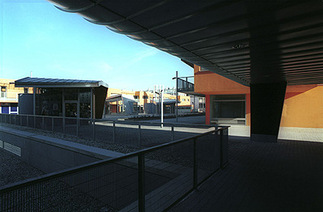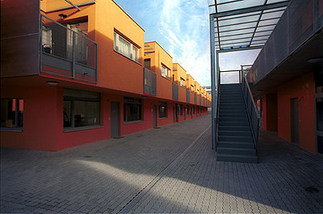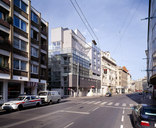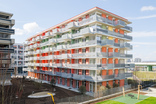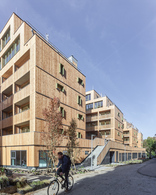Bauwerk
Compact City
BUSarchitektur, Rainer Lalics - Wien (A) - 2001
7. Januar 2002 - Az W
The „Compact City“ development, along with its residents, the so-called „home workers,“ is a pilot project for special ways of living. The winning project of the Otto Wagner Prize for Urban Planning of 1998, it was based on urban planning research and site development studies.
BUS is a group of architects that examines the „potential combinations among the hybrid structures“ of living and working in a space adapted for both. Hence, the inclusion of working places within, or adjacent to, the apartments is the defining element of the facility which contains 59 apartments, 12 artists’ studios, 10 workshops with additional exterior working spaces, 4 small businesses, restaurants, offices, retail stores and playgrounds.
The positive effects of this architectural experiment on urban planning and social structures are numerous: the „home workers’“ rhythm of living revitalizes a previously mainly residential area; the notion of dwelling as such loses its mono-functional character and becomes an integral part of a social network; a higher demand on pedestrian pathways results in a significant reduction of motorized traffic; the building façades can be for advertising; green areas serve as valuable islands for recreation and creative activities.
The idea of combining an ecological urban development with this merged living and working space, in order to counteract suburban ghettoization, is undoubtedly an important step towards redefining urban growth. (Text: Gabriele Kaiser)
BUS is a group of architects that examines the „potential combinations among the hybrid structures“ of living and working in a space adapted for both. Hence, the inclusion of working places within, or adjacent to, the apartments is the defining element of the facility which contains 59 apartments, 12 artists’ studios, 10 workshops with additional exterior working spaces, 4 small businesses, restaurants, offices, retail stores and playgrounds.
The positive effects of this architectural experiment on urban planning and social structures are numerous: the „home workers’“ rhythm of living revitalizes a previously mainly residential area; the notion of dwelling as such loses its mono-functional character and becomes an integral part of a social network; a higher demand on pedestrian pathways results in a significant reduction of motorized traffic; the building façades can be for advertising; green areas serve as valuable islands for recreation and creative activities.
The idea of combining an ecological urban development with this merged living and working space, in order to counteract suburban ghettoization, is undoubtedly an important step towards redefining urban growth. (Text: Gabriele Kaiser)
Für den Beitrag verantwortlich: Architekturzentrum Wien
Ansprechpartner:in für diese Seite: Maria Welzig
Presseschau
Akteure
ArchitekturBauherrschaft
Tragwerksplanung
Fotografie
